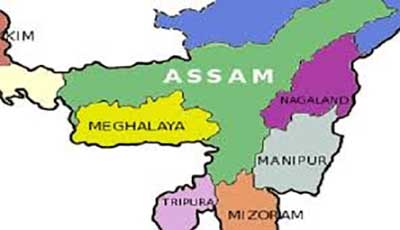Date: 26/11/2022
Relevance: GS-2: Issues and Challenges Pertaining to the Federal Structure.
Relevance: GS-3: Internal Security; Inter-State Boundary Disputes.
Key Phrases: Assam-Meghalaya border, Assam Reorganisation (Meghalaya) Act of 1969, Autonomous State, Joint Official Committee 1983, Delineation, Demarcation, Survey of India, Zonal councils.
Context:
- The recent firing incident on the Assam-Meghalaya border has put the focus on the five-decade-old boundary issue between the two northeastern states.
Key Highlights:
- On November 22, five villagers from Meghalaya and an Assam forest guard were killed and two others were seriously injured in a firing incident along the boundary between the two States.
- On March 29, Assam and Meghalaya partially resolved a
50-year-old dispute along their 884.9 km boundary.
- It was facilitated by the Home Minister of India who urged the States to resolve their boundary disputes by August 15, 2022, when the country celebrates 75 years of Independence.
Reason of Dispute:
- Assam and Meghalaya share an 885-km border. In 1972, Meghalaya
became a full-fledged state following the Assam Reorganisation (Meghalaya)
Act of 1969.
- This was the beginning of the border problem as the Meghalaya government found the Act unacceptable.
- This was because the act followed the recommendations of a 1951
committee to define the boundary of Meghalaya.
- On that panel’s recommendations, areas of the present-day East Jaintia Hills, Ri-Bhoi and West Khasi Hills districts of Meghalaya were transferred to the Karbi Anglong, Kamrup (metro) and Kamrup districts of Assam.
- Meghalaya contested these transfers after statehood, claiming that they belonged to its tribal chieftains.
- Assam said the Meghalaya government could neither provide documents nor archival materials to prove its claim over these areas.
- As many as 12 land dispute points, along the border of these two
states, have been a bone of contention.
- These include Langpih, Upper Tarabari, Gazang reserve forest, Hahim, Borduar, Boklapara, Nongwah, Matamur, Khanapara-Pilangkata, Deshdemoreah Block I and Block II, Khanduli and Retacherra.
Efforts Made to Solve the Issue:
- Joint Official Committee 1983
- It was formed to address the border issues.
- The panel recommended that the Survey of India should re-delineate the border, teaming up with both the states.
- Independent Panel 1985
- An independent panel, spearheaded by Justice YV Chandrachud, was set up in 1985.
- Meghalaya rubbished the report.
- Demarcation of Border 1991
- In 1991, about 100 km of the border was demarcated with the help of the Survey of India, but Meghalaya cried foul.
- Meghalaya Assembly Resolution 2011
- In 2011, the Meghalaya Assembly passed a resolution for intervention of the Centre and the establishment of a boundary commission.
- The Centre asked the two governments to appoint nodal officers to discuss the dispute.
- Assam and Meghalaya Draft Resolution Jan 2022
- On January 29 this year, Assam and Meghalaya signed a draft resolution.
- It was the first step towards resolving a 50-year-old dispute.
- MoU between Assam and Meghalaya March 2022
- On March 29, a historic MoU was signed between Assam Chief
Minister Himanta Biswa Sarma and his Meghalaya counterpart Conrad K
Sangma in the presence of Home Minister Amit Shah in New Delhi.
- Six (Tarabari, Gizang, Hahim, Boklapara, Khanapara-Pilangkata and Ratacherra) of 12 dispute areas have found some type of resolution in the memorandum of understanding (MoU).
- Out of 36.79 sq km of disputed area taken up for settlement in the first phase, Assam would get full control of 18.46 sq km and Meghalaya of 18.33 sq km.
- On August 22 this year, the second phase of border talks was held with the two states deciding to form three regional committees to resolve issues regarding the remaining six disputed areas.
- Five principles are considered while resolving the border disputes: historical facts, ethnicity, administrative convenience, willingness and sentiments of the people concerned and the contiguity of the land, preferably with natural boundaries such as rivers, streams, and rocks.
- On March 29, a historic MoU was signed between Assam Chief
Minister Himanta Biswa Sarma and his Meghalaya counterpart Conrad K
Sangma in the presence of Home Minister Amit Shah in New Delhi.
Way Forward:
- These man-made border lines should not be allowed to restrict the movement of people in pursuit of a livelihood.
- The BJP is in government in much of the northeast and has the
leverage to aim for a resolution of all outstanding disputes in the
region.
- So the Union Government should work for a comprehensive and sustainable resolution.
- Delineation and demarcation of the boundary must be done by Survey of India in the presence of representatives of both governments based on agreed resolutions.
- Zonal councils need to be revived to discuss the matters of common concern to states.
Conclusion:
- To strengthen the unity of India, there is a strong need for the settlement of such border disputes so that the dream of “Ek Bharat, Shresta Bharat”can be fulfilled.
Source: The Hindu
Mains Question:
Q. What are the main reasons for the border disputes between Assam and Meghalaya? Also, critically analyze the efforts that are made to solve the issue. (150 Words).








